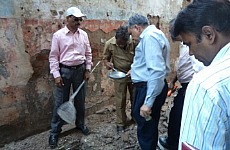Rajander Sharma has devoted a lifetime to vector control in India, applying advanced entomological techniques discovered as a TDR grantee and contributing to the reduction of malaria in the country.
Dr Sharma spent most mornings in the first eight years of his career collecting mosquitoes and larvae (the eggs they lay) in aspirator tubes to take back to the office and laboratory to analyse. “The highest density of mosquitoes is in the early morning and evening,” he explains. “So between 5 and 6 am my team and I would go to construction sites where large containers, plastic tyres, water coolers and discarded plastic cups which collect rainwater were perfect breeding sites for mosquitoes.” |  Rajander Sharma |
Those early morning trips in his first job for state-level government in Haryana on urban malaria control provided vital information about species transmission, seasonal abundance and breeding and shaped India’s national vector control programme
– of which Sharma is a main architect – with notable success.
Now in a downward trend, the number of malaria cases in India has fallen from 6.4 million in 1976 when the programme was first established to less than two million cases. Sharma says field work has been the most important part of his job: “Every week we collected the species to provide baseline information relating to vectors, population density and viral load.”
Advanced entomological techniques in vector control
Sharma’s PhD doctoral thesis was on ecological factors in the mosquitos anopheles culicifacies and anopheles stephensi – major vectors for urban malaria in India. As a biologist, he went on to pioneer several biological interventions and non-chemical alternatives in the South-East Asia Region
These include larvivorous fish that eat the mosquito eggs used in different combinations for different vectors with chemical agents such as temephos in clean water, insecticidal crystal proteins of Bacillus thurngiensis, mosquito larvicidal oil, difubenziron and pyreproxyfen, dichlorodiphenyltrichloroethane (DDT) and long-lasting insecticidal nets (LLNs).
Fifty percent of entomologists’ jobs lie vacant.
A TDR grant in 1993 funded his research in molecular biology and human malaria vectors at the Centre for Biotechnology at Anna University, Madras. With this, he carried out blood meal analysis of disease vectors using the enzyme-linked immunosorbent assay (ELISA) test.
In the mid-90s, a second TDR grant sent him to the London School of Hygiene and Tropical Medicine and Imperial College, Ascot London to study advanced entomological techniques for all vector-borne diseases. He brought new methods he developed back to the national control programme and centre for disease control. These were adopted for monitoring insecticide resistance, identifying which blood groups mosquitoes prefer as ‘hosts’ and detecting "sporozoites ELISA" – the parasites an infected mosquito injects into a person when feeding on them. These new tools were integrated into the country’s control and training.
Professor Aditya Prasad Dash, former regional director of neglected tropical diseases in the World Health Organization’s Regional Office for South-East Asia (SEAR), says, “During his tenure in the national programme, Dr Sharma trained thousands of scientists, imparting his great professional knowledge and technical skills in the containment of vector-borne diseases.”
Sharma has published extensively. He is India’s representative on several United Nations bodies including the UN Environment Programme (UNEP) global partnership for the development and deployment of alternative methods and strategies to DDT use for disease vector control, and the region’s vector expert for the Technical Expert Group on Malaria Vector Control in Geneva.
In 2013, he was given the Bayer science award in the field of vector-borne diseases by the National Academy of Vector and Vector-Borne Diseases. He recently received the field entomology award from the Indian Society in recognition of this work on malaria and other communicable diseases.
Dramatic decline in urban malaria due to larvicides
Sharma says rapid urbanization means malaria in cities has become much more of a problem than in rural areas and requires special interventions: “Bednets are not feasible in most of the very small spaces in which people live. They are often the same size as people’s houses. You cannot just apply the same techniques as in rural areas.”
Sharma helped shape policy to address these specific needs, putting in place a combination of anti-larval measures that are chemical, such as temephos in clean water, and biological, small fish, such as gambusia affinis and poecilia reticulata that eat the larvae – administered weekly. These efforts, along with regular monitoring, have led to a dramatic decline in malaria in India’s 131 cities from 24% in 1970 to just under 8% in 2012.
Vector control changes
In the span of Sharma’s career, the picture of India’s vector-borne diseases has changed significantly: “The national programme is now putting more emphasis on dengue,” he says. “Dengue transmission is more of a worry in India than malaria today.”
 Rajander Sharma | He regrets the lack of trained entomologists now facing the national programme. “Fifty per cent of entomologists’ jobs lie vacant.” He says more young people in India are going into computer science and engineering, and there’s a real need, particularly as diseases like Zika show what a huge impact they can have on whole regions. |
For more information, contact:
Makiko Kitamura
TDR Communications Officer
Telephone: +41 22 791 2926
email: kitamuram@who.int

